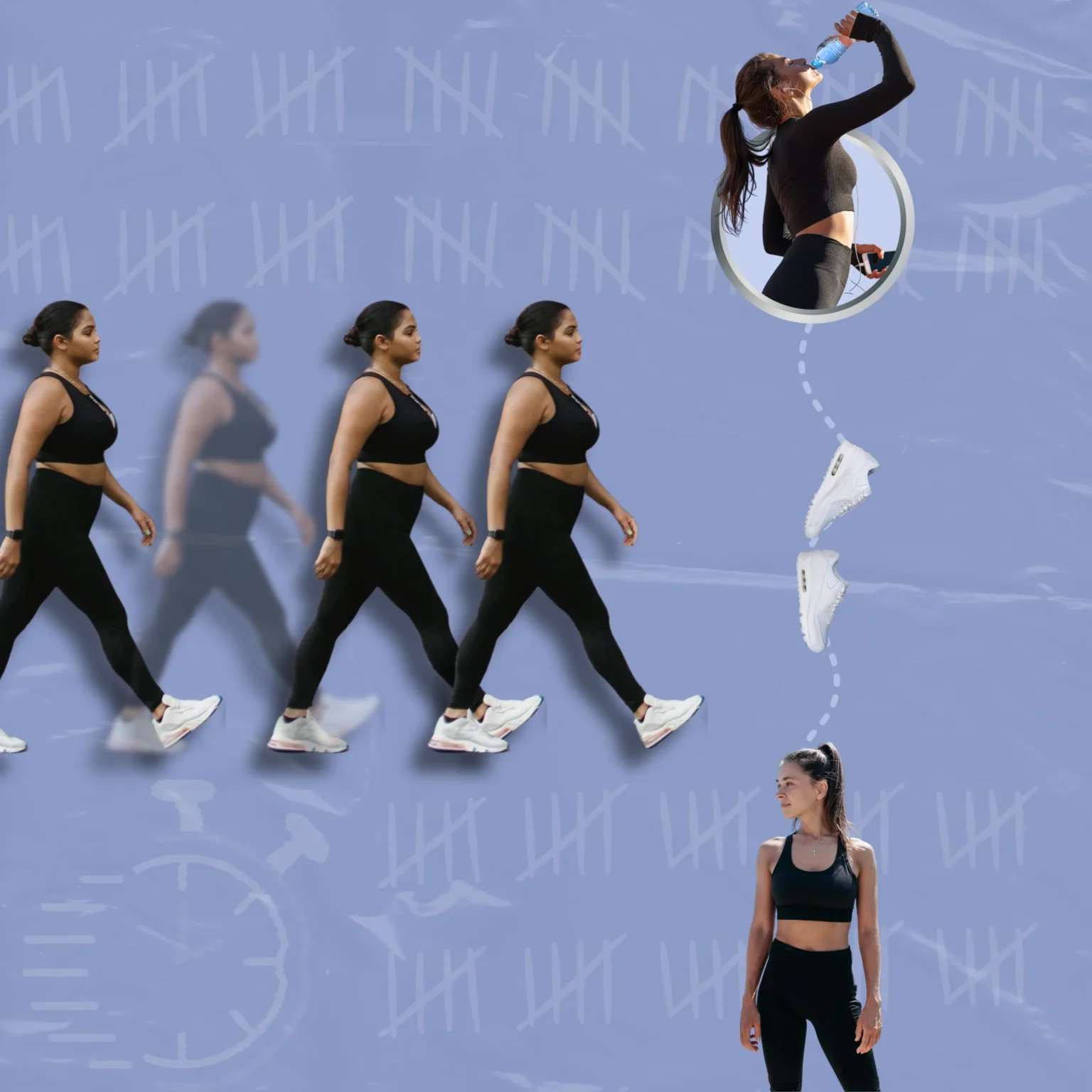
For many of us, the best part of the day comes right after a satisfying morning workout. When that post-exercise high kicks in, it becomes tempting to skip rest days. Some of us have been conditioned to believe that just one day off is enough, all in the name of ‘staying disciplined.’ As a fitness enthusiast and someone who has been on this journey for over four years, I’ve leaned on many sides of this spectrum. When the benefits seem so good, it’s tough to convince yourself to take a break. Whether it’s the strong motivation or the belief that pushing harder keeps you ahead, it’s important to remember that more isn’t always better. According to Sarah Kostyukovsky, P.T., DPT, OCS, rest days are crucial in preventing over-stimulation of the body and the excessive production of cortisol, a stress hormone (more on this shortly).
You might have heard, taking rest is as important as the workout itself. But how important is it, really? How many rest days should I take in a week? Is one day more than enough? How do I recognize if I am just making excuses or if my body is genuinely asking for a day off? Honestly, I had no clue, so I did what any good writer would do—I researched and consulted the experts. If you’ve ever found yourself puzzled about rest days or asked any of those questions, this one’s for you. Dive into my exploration of everything you need to know about rest days and come across insights straight from the experts.
In this article
- Benefits of taking rest regularly
- Signs your body is begging for rest
- Guidelines for incorporating rest days into various workout routines
- What to do on rest days
Benefits of taking rest regularly
Let’s get a little technical (just a bit, I promise).
1. Rest days help you get stronger
Rest days allow your body to bounce back from the strain of workouts. Here’s the lowdown: muscles grow when your body makes more proteins than it breaks down. When you work out, your muscles develops tiny tears, triggering special cells called satellite cells to kick into action. These cells repair the ‘damaged’ muscle fibers by bonding together. While this repair process is complex and involves various factors, allowing sufficient rest time is crucial for it to happen (no, sleep time alone doesn’t count).
If you don’t give the muscles the time they need to recover, the tears build up, resulting in muscle fatigue and poor performance. Bianca Grover, the Exercise Physiologist, Medical Exercise Specialist, and Health Coach behind Bianca Grover Fitness explains “Adequate rest allows our tissues to repair and adapt to the challenge imposed by our workouts.”
2. It reduces the risk of injuries
Speaking of muscle fatigue, putting too much strain on our bodies can result in overuse injuries like stress fractures, muscle strains, and joint pain. Bianca breaks it down with a great example: imagine deadlifting at near-maximal effort every single day with no rest in between. The muscles involved in the movement become overworked, resorting to the path of least resistance—what we call compensation and a direct route to getting injured.
Dealing with these injuries means spending more time on the sidelines—a setback none of us want to face. Planning rest days strategically can effectively minimize accumulated strain on your body while supporting a solid recovery from physical exertion.
3. It improves your quality of sleep
Alright, aside from life’s essentials—your ever-reliable besties, the SPF acting like a superhero for your skin, and those irresistible TikTok how-to videos—nothing quite tops a good night’s sleep, especially when it comes to athletic performance and maximizing your workouts.
When we hit the gym or get active, our bodies releases hormones such as adrenaline and cortisol (AKA stress hormone). In moderation, these hormones are fantastic but when we skip rest days, they can overload, throwing off our sleep patterns. So, if you’re suddenly craving daytime naps or hitting the hay earlier than your usual bedtime, it might be your body saying, ‘I need a breather from this workout routine.’ To fight off that fatigue, rest days become your golden ticket to dodge burnout and ensure you’re all set to conquer those planned workouts.
4. And, it gives you time
Time to spend with your loved ones, to read more, to prepare wholesome meals, go on a walk in nature, or simply catch up with whatever life has to offer. Rest days basically offer a chance to nurture yourself holistically. Often, such things get sidelined when time becomes a constraint. Allocating 1-2 rest days can grant you the opportunity to not only attend to weary muscles but prioritize mental health, and address all the integral components of health and fitness. Fitness isn’t solely about exercise; numerous other factors significantly contribute to keeping you fit. So, give them the time and TLC they rightfully deserve.
Surprising signs your body is begging for rest
Your workouts are getting super difficult
Feeling challenged during workouts is normal, but if exercises that are usually manageable become excessively tough, your body might be signaling a need for a break. According to Kostyukovsky, this difficulty might arise due to your body requiring recovery from the muscle breakdown that comes with intense training.
You are not able to sleep or you’re sleeping a lot
Excessive production of adrenaline and cortisol can disrupt your sleep patterns, affecting your energy levels during workouts and potentially causing fatigue throughout the day. This imbalance in stress hormones can also have a domino effect on your overall well-being, influencing both your exercise performance and daily vitality.
You are feeling stressed/irritated
Feeling a bit more stressed or on edge lately? It might not just be the busy schedule weighing you down. Both Sarah and Bianca point out that the mental strain and restlessness could be stemming from consistent workouts. While they’re fantastic for releasing pent-up tension, they can also slowly wear you out.
Your soreness doesn’t want to leave your side
Experiencing soreness post-workout is pretty normal, but if it lingers as consistent pain, it’s a big no-no. Whether it’s in your muscles or joints, ongoing discomfort might signal an overuse injury. Also, keep an eye out for prolonged fatigue; it could hint at systemic inflammation caused by intense training.
Few other surprising signs
Other surprising “signs of physical and mental burnout include joint stiffness, GI issues, low energy, forgetfulness and impulsiveness, difficulty concentrating on tasks, elevated resting heart rate and blood pressure, frequent bouts of sickness, and even a reduced sex drive.” elaborates Bianca.
Guidelines for incorporating rest days into various workout routines
The ideal number of rest days per week depends on what workouts the individual is engaging in, their current fitness level, and their lifestyle which includes nutrition, sleep, occupation, etc. Someone who is a runner will have different requirements for rest days compared to someone who practices yoga for instance. Really listening to your body will help you know if your are over training.
For cardio
Usually, easy-breezy cardio activities like strolls or laid-back dance sessions don’t necessarily demand designated rest days and can be a part of your daily routine unless advised otherwise by a healthcare professional. Yet, when diving into moderate or intense aerobic exercises, carving out rest days becomes a must. It’s recommended to slot in rest days every three to five days. For those hustling with high-intensity cardio, squeezing in more frequent rest days is key.
According to the World Health Organization, adults aged between 18 -64 are encouraged to clock in 150 to 300 minutes of moderate activity or 75 to 150 minutes of vigorous activity per week.
For weight-training
Incorporating rest days into an exclusive weight training or bodybuilding regimen can be accomplished through a method known as muscle rotation. This technique involves focusing on a particular muscle group during workouts, allowing for a one to two-day recovery period afterward. The remaining days are dedicated to targeting different muscle sets while ensuring engagement of opposing muscles, thereby promoting overall body balance and recovery.
Grover, who dedicates herself to boot-camps twice a week and intense weightlifting sessions thrice a week, strategically factors in two essential rest days within her routine. These days typically fall between her metabolic conditioning and strength-focused sessions. And when faced with an exceptionally demanding week, she listens to her body’s cues and reduces the resistance load during her strength training to aid recovery. She also emphasizes the importance of incorporating mobility sessions into her schedule. Fostering good mobility not only elevates performance and recovery but also acts as a preventative measure against potential injuries.
For weight loss
Even if your goal is weight loss, it’s crucial to incorporate regular rest days into your routine. Taking time to rest enables your muscles to regenerate and develop. Building more muscle contributes to increased calorie burn even when at rest, as muscle demands more energy than fat. Moreover, feeling revitalized will increase your commitment to sticking to your exercise regimen.
What to do on rest days
1. Focus on diet
As someone who isn’t a huge fan of portion control, I tend to track my calorie intake, enjoying the satisfaction of seeing an increase in calories after finishing my workout. However, on rest days, the calorie intake doesn’t surge as our bodies generally need fewer calories due to reduced activity levels. For those, like me, who prefer not to track calories regularly, tuning into your body’s cues for hunger and fullness on rest days (a significant mental and physical relief) can help. You’ll find that your body naturally adjusts its demands.
However, I’m still particular about maintaining adequate protein intake because it play a critical role in supporting muscle recovery during rest periods. The Food and Drug Administration recommends an average daily protein intake of about 50 grams (g) for most adults in the US. But the exact amount can vary depending on factors like age, sex, health condition, and activity levels. For those who are active, aiming for 1.2 to 2.0 grams of protein per kilogram of body weight each day is suggested, and it’s best to spread this intake evenly across the day.
2. Drink your water and do your thing
Fun fact: Muscles are approximately 80% water! When you’re diving into those intense workout sessions and breaking a sweat, keeping hydrated becomes an essential part of performing at your best. Surprisingly, even a mere 2% loss in your body’s water content can notably impact your physical performance. Staying hydrated isn’t just going to help you avoid muscle cramps; it’s also your ticket to better sleep quality, balanced hormones, and smoother digestion. So, don’t forget to drink your water while you do your thing and catch up with your favorite people, food and TV shows.
3. Try some rest day friendly workouts
If taking a breather feels unfamiliar or too fresh, don’t worry! Low-impact workouts are a great option. “Engaging in low impact cardiovascular activity will increase your circulation and activate your musculoskeletal system which will help to resolve inflammation in the body which occurs after a more intense workout. This active recovery can reduce muscle soreness and prepare the body for your next HIIT workout or weight training day.” Kostyukovsky explains .
Here are some expert recommended low impact workouts you can enjoy on your rest days:
- Walking (outside with a friend, or completing your daily step goals maybe?)
- Easy Cycling
- Mobility training and Foam Rolling
- Yoga or Tai Chi
- Pilates, anyone?
- Swimming (make it a fun pool day)
- Dancing (yep, those TikTok routines totally count considering it takes forever to make one)

